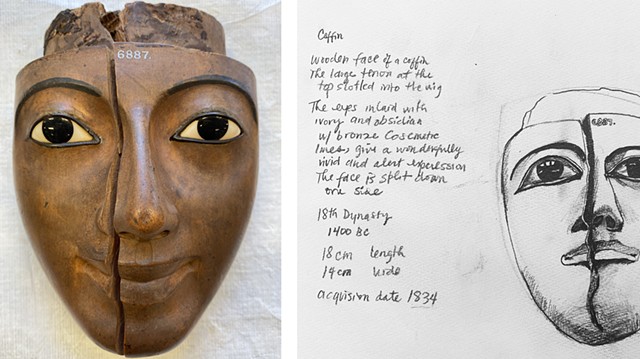Histories Collide
The British Museum holds the largest collection of Egyptian antiquities outside of Egypt, with nearly 100,000 Ancient Egyptian objects. For the past couple of years, I have been utilizing their online collection and study room program, to make drawn renditions of the antiquities in their collection, which I later site in my work. By collaging my drawings of these artifacts I reinterpret and reclaim these historical objects of my heritage. This image is of one such object and my notes.
For a few years, previous to this project, I used the British Museum and MET’s online databases for visual research. The British Museum has nearly 100,000 Ancient Egyptian objects– for context, the Baltimore Museum of Art’s entire holdings (everything) is about 100,000. I was mostly interested in smaller objects with personal applications, textiles, shabtis, amulets, funerary masks and so on. I draw these objects and then collage my drawings into the context of my work. By collaging my drawings into my complex paintings, I reinterpret these historical objects found in the British Museum’s holdings. At the same time, I create an ongoing database so I can easily reference my selected individual objects' history or provenance. I see this as a form of reclaiming the objects of my heritage. And for this project at the BMA, I traveled to London to visit the British Museum where I requested to see several objects from their Ancient Egyptian collection. I also conducted a similar process at the BMA as well, looking at their Egyptian holdings. This up-close and personal experience with antiquities was life changing. I wasn’t prepared for how emotional this experience would be. I intend to go back again as much as possible.
As we’ve all begun to accept, museums are a political place. I’m very much interested in the history of acquisition as a political act.
